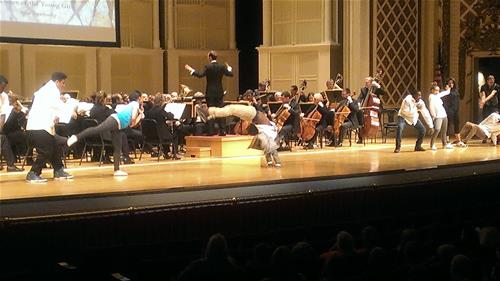posted by Rebecca Bromels ON
Feb 10, 2015
What happens when young hip hop dancers share the stage with a professional symphony orchestra? Tom Kent, Executive Director of Elementz Hip Hop Center for Youth, discovered that this kind of surprising artistic collaboration can break down pre-conceptions of both artists and audiences. We asked Tom to share with us how Elementz’ recent partnerships with the Cincinnati Symphony Orchestra, the Cincinnati Ballet, the Cincinnati Boychoir, and others have influenced their young artists and their plans for the future.
What inspired Elementz to seek out collaborations with other arts organizations in the past year?
 Tom: We were first approached by the Cincinnati Pops with a request for our dancers to perform at their Holiday concert three years ago, and then multiple contacts from the Cincinnati Symphony Orchestra (CSO) and Taft Museum to share visiting artists when they came to town. This got us thinking that collaboration artistically might be possible. We particularly took notice when the CSO brought Daniel Bernard Roumain, a Hip Hop-inspired violinist and composer, to town to perform one of his hip hop-inspired works. However, it was the multiple occasions when Elementz was included in meetings sponsored by ArtsWave that we were able to meet and get to know the creative leaders in the arts organizations who were open to ideas about collaboration.
Tom: We were first approached by the Cincinnati Pops with a request for our dancers to perform at their Holiday concert three years ago, and then multiple contacts from the Cincinnati Symphony Orchestra (CSO) and Taft Museum to share visiting artists when they came to town. This got us thinking that collaboration artistically might be possible. We particularly took notice when the CSO brought Daniel Bernard Roumain, a Hip Hop-inspired violinist and composer, to town to perform one of his hip hop-inspired works. However, it was the multiple occasions when Elementz was included in meetings sponsored by ArtsWave that we were able to meet and get to know the creative leaders in the arts organizations who were open to ideas about collaboration.
What do you think are the benefits of these collaborations for the young artists at Elementz? What about the benefits to the larger community?
Tom: The young people we work with tend to be isolated from the larger community and like most of us, like to hang out with people they already know and where their surroundings are familiar. Through our collaborations however, they have been inside buildings they might never have entered, including Music Hall, Memorial Hall, the Freedom Center and the Art Museum, not to mention major corporations such as P&G and Duke Energy. Of course, this works in reverse also, as the larger community meets these gifted young people and begins to embrace them.
How have these collaborations changed how you think about your work and your plans for the future? What impact have you seen on the students who participate?
Tom: We have determined that a focus on collaborative performances is the best way to achieve our goals for our talented youth, as through collaboration with other groups, we can put them on a larger stage and expose them to a larger audience. For the youth, the opportunity to perform and be recognized in front of hundreds or thousands, and to read about their performance in the media is a real boost to their confidence. It also drives a high level of preparation and increased skill in their chosen art form.
Do you have a “big idea” collaboration/dream that you’d like to share?
Tom: We are going to dance with concert:nova this April and will choreograph ten original works to the music of John Adams. We think the combination of classical music and dance interpretation (for instance) has value in “connecting the dots” for the audience. We certainly saw this at Music Hall when our dancers did an interpretation of a movement of Stravinsky’s “Rite of Spring” for a youth concert. The young people in the audience suddenly came to life and “got” what the music was about. We are watching the CSO’s experiment with the Music Now festival and find that intriguing. We also hope to find other ways to involve other artists in future collaborations. Besides our street dancers, we have excellent Spoken Word artists, singers, song writers and electronic music composers, all of whom participated in last year’s collaboration with the Cincinnati Boychoir.
